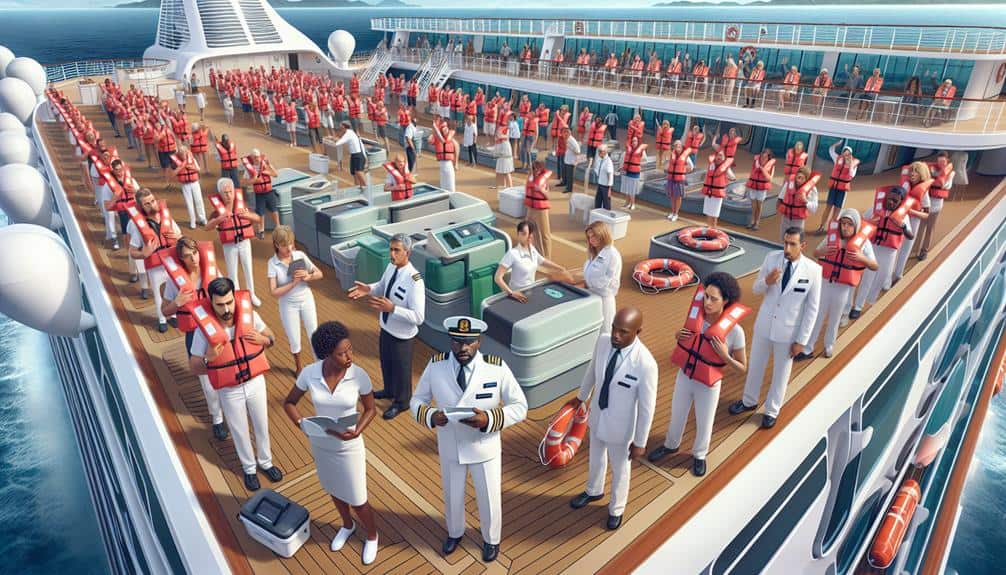Guarantee cruise ship safety by adhering to industry guidelines for drill frequency. Conduct mandatory drills within 24 hours of boarding and weekly crew drills for various emergency scenarios. Evaluate drill effectiveness to establish schedules. Adherence to regulations is essential, incorporating risk assessments and diverse scenarios. Monitor compliance through evaluation methods like video recordings and debriefings. Prioritize crew engagement and communication protocols. Enhance safety preparedness by implementing high-quality emergency drills. For more in-depth insights on maximizing safety through drill frequency, explore factors influencing the schedule and the importance of regular safety drills.
Key Points
- Follow industry standards for drill frequency.
- Conduct mandatory drills within 24 hours of boarding.
- Engage in weekly crew drills for specific scenarios.
- Evaluate drill effectiveness and crew participation.
- Implement diverse scenarios and feedback mechanisms for improvement.
Importance of Regular Safety Drills
Regular safety drills are crucial for guaranteeing that all crew members and passengers are well-prepared for emergencies onboard cruise ships. Crew engagement plays a pivotal role in these drills. Crew members must be thoroughly trained to respond effectively to various emergency scenarios. This includes familiarizing themselves with emergency procedures, such as fire drills, man overboard drills, and abandon ship drills. By actively participating in these drills, crew members can hone their skills, enhance coordination, and ensure a rapid and efficient response in real-life emergency situations.
Passenger awareness is another critical aspect addressed during safety drills. It's imperative for passengers to be informed about safety protocols, emergency exits, life jacket locations, and muster station procedures. Regular drills help passengers become familiar with these safety measures, reducing panic and confusion during actual emergencies. By actively involving passengers in safety drills, cruise ships can enhance overall preparedness and ensure a safer environment for everyone onboard. Remember, a well-prepared crew and informed passengers are key to maximizing safety at sea.
Recommended Drill Frequency Guidelines
Adhering to industry standards, safety drill frequency guidelines on cruise ships are meticulously outlined to guarantee peak preparedness in emergency situations. Drill efficiency is a key aspect of these guidelines, with industry regulations suggesting that mandatory drills should be conducted within 24 hours of boarding. Additionally, it's recommended to have weekly crew drills focusing on specific emergency scenarios like fires, man overboard situations, and abandon ship procedures.
Crew engagement is paramount during these drills to make certain that each member understands their role and responsibilities. Regular practice not only enhances individual competency but also fosters teamwork and coordination among crew members. Cruise lines are encouraged to incorporate realistic scenarios into their drills to simulate actual emergency situations, thereby preparing the crew for swift and effective responses. By following these recommended drill frequency guidelines and emphasizing drill efficiency and crew engagement, cruise ships can greatly enhance their overall safety preparedness.
Factors Influencing Drill Frequency
To determine the appropriate frequency of safety drills onboard cruise ships, it's imperative to take into account various factors that directly impact the efficacy of emergency preparedness measures. Drill effectiveness plays a critical role in deciding how often safety drills should be conducted. Regular drills help in familiarizing the crew with emergency procedures, ensuring a smoother response during actual emergencies. Crew participation is another essential factor influencing drill frequency. Active involvement of all crew members in safety drills enhances their preparedness and response capabilities, ultimately contributing to a safer environment for passengers.
Emergency response is a key consideration when determining drill frequency. The quicker and more efficient the response during drills, the better prepared the crew will be to handle real emergencies. Communication protocols are also essential in this regard. Regular drills provide opportunities to test and improve communication systems, ensuring that information flows effectively during crises. By evaluating these factors, cruise ship operators can establish drill schedules that maximize preparedness and safety onboard.
Implementing Effective Drill Schedules
When crafting effective drill schedules for cruise ships, it's essential to meticulously plan and strategize to guarantee high-quality emergency preparedness and crew readiness. To ensure drill efficiency and crew training, consider the following key factors:
- Regulatory Compliance: Align your drill schedules with international maritime regulations such as SOLAS (Safety of Life at Sea) to meet the required standards and enhance safety protocols.
- Risk Assessment Integration: Incorporate risk assessments into your scheduling process to prioritize drills based on potential hazards and vulnerabilities specific to your cruise ship.
- Scenario Diversity: Develop a diverse range of emergency scenarios within your drill schedules to expose crew members to various crisis situations and ensure they're well-equipped to handle any challenge.
- Feedback Mechanisms: Implement feedback mechanisms post-drills to evaluate performance, identify areas for improvement, and fine-tune future schedules for enhanced crew training and emergency response preparedness.
Monitoring and Evaluating Drill Compliance
Crafting an effective monitoring and evaluation system for drill compliance on cruise ships involves meticulous documentation and analysis of crew performance during emergency drills. Evaluation methods play a vital role in guaranteeing compliance with safety protocols. To monitor drill compliance effectively, cruise lines utilize various evaluation methods such as video recordings, observations by designated safety officers, and post-drill debriefings. These methods allow for a thorough assessment of drill performance, identifying areas for improvement and ensuring that crew members adhere to established emergency procedures.
Regularly reviewing and analyzing drill performance data is essential for identifying trends, patterns, and discrepancies. By comparing current drill performance against established benchmarks and regulatory requirements, cruise lines can gauge the effectiveness of their safety training programs and emergency response protocols. This continuous monitoring and evaluation process not only guarantees regulatory compliance but also enhances overall safety preparedness on cruise ships.
Frequently Asked Questions
Are There Any Legal Consequences for Cruise Ships That Do Not Adhere to Recommended Drill Frequencies?
If cruise ships do not adhere to recommended drill frequencies, legal consequences can include enforcement penalties. Adherence to safety protocols is essential to meet regulations. Failure to do so may lead to fines or other sanctions.
How Do Cruise Lines Ensure That All Crew Members, Including New Hires, Receive Proper Safety Drill Training?
When onboarding new crew, cruise lines guarantee safety by conducting thorough safety drill training. Consistency in procedures and effectiveness in conveying emergency protocols are vital. Regular refreshers and assessments guarantee readiness for any situation at sea.
Are There Specific Drills or Scenarios That Are More Effective in Preparing Passengers for Emergencies?
To prepare passengers for emergencies effectively, engage in interactive drills focusing on realistic scenarios. Guarantee thorough understanding of emergency procedures by actively involving passengers in drills that simulate potential onboard incidents for best safety readiness.
What Measures Are in Place to Ensure That Passengers With Disabilities or Special Needs Are Included in Safety Drills?
To guarantee all passengers, including those with disabilities or special needs, are included in safety drills, accessibility accommodations and inclusive training are in place. Communication strategies and special needs considerations are incorporated to ensure thorough emergency preparedness.
How Do Cruise Lines Handle Language Barriers During Safety Drills for Multinational Crews and Passengers?
When managing language barriers during safety drills for multinational crews and passengers, cruise lines utilize multicultural communication training techniques. These focus on emergency response and overcoming language barriers through specialized training and clear communication protocols.




